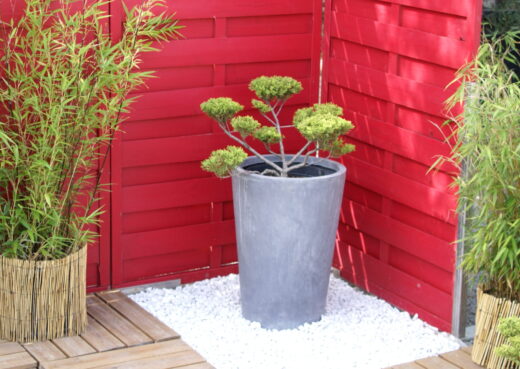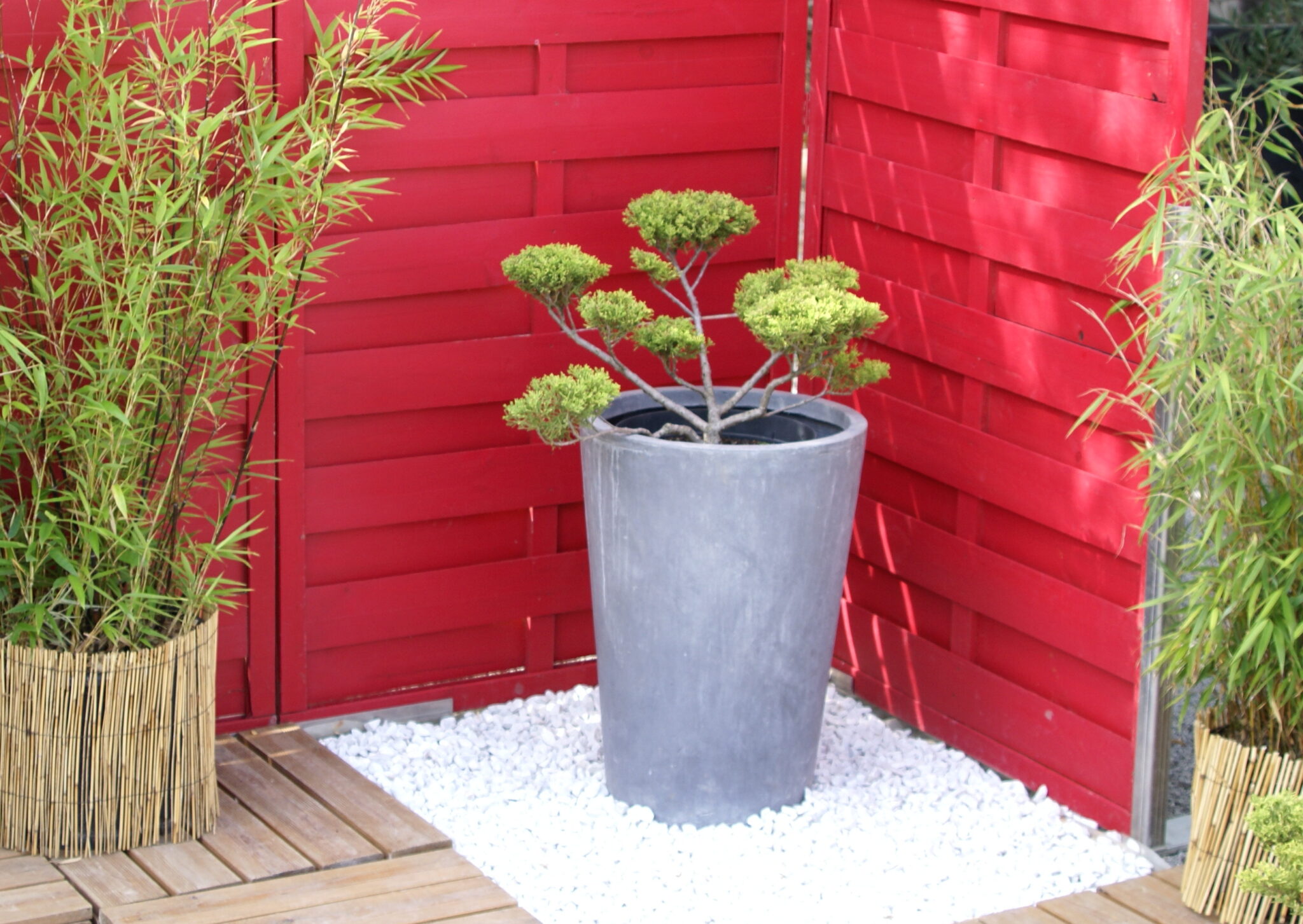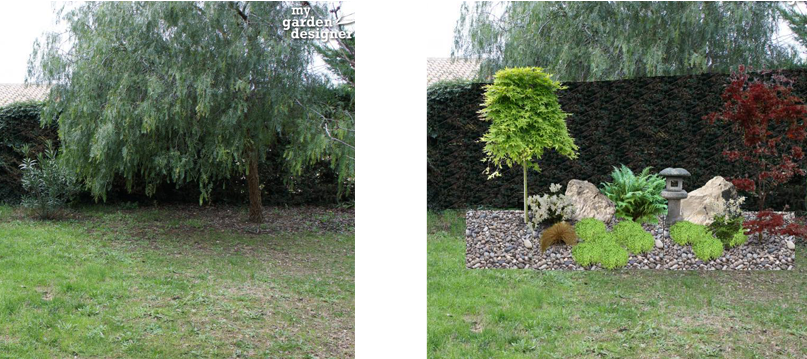
Today we’re going to take a look at the different Japanese gardens and the secrets to their success.
Contrary to our Western vision, there are actually not one but five main types of Japanese garden. These come in a variety of styles, to suit different tastes and constraints (space, exposure, climate, aesthetic choices…).
Some Japanese gardeners manage to combine these different styles in one large space.
Perhaps even more than in other garden styles, the Japanese Garden demands precision of execution to achieve the right result. Otherwise, it’s always possible to create a Japanese Garden by following some of the basic rules we’ll detail at the end of this article, but without applying everything to the letter.
Here are the 5 main types:
Karesansui: The Dry Garden or Zen Garden
Otherwise known as the mineral garden, it’s the most minimalist, easiest to maintain and adaptable to all garden and terrace surfaces, and the least expensive.
It consists of a mineral bed (gravel, coarse sand) from which emerge 3 groups of stones with very distinct shapes (a high vertical, a low vertical, a flat horizontal).
A few typical plants (cloud tree, azalea, Mahonia) can be added in isolation, in the ground or in pots.
Cha-niwa: The tea garden
The best-known Japanese garden for small and medium-sized areas. It’s best suited to small spaces. It is marked by the decorative elements with which it is inseparable: Japanese steps, Japanese lantern, Japanese tsukubai fountain with its gentle murmur.
It’s an intimate garden, hidden from the outside world, where you can discover the various Japanese decorative objects hidden in 2 or 3 distinct spaces separated by vegetation. Bamboos, boxwood, Japanese fusain, rhododendrons…give structure to this space.
Kaiyushiki teien: The walking garden
As its name suggests, this garden requires more space, as it’s a Japanese garden where you walk around recreating scenes inspired by travels. Lakes, streams, bridges and hills form the backdrop for the larger areas. Otherwise, ponds and Japanese lanterns will suffice for smaller areas. It’s not partitioned, so you have to be able to see the whole garden as you enter.
The plants are proportional to the space and therefore more imposing: Flowering cherry, pine, weeping sophora and magnolia.
Zukuri: The borrowed landscape
The Borrowed Landscape Japanese Garden ideally requires a natural landscape as a backdrop, into which the vegetation of your Japanese garden will blend seamlessly in the foreground. The size of your actual garden is of little importance.
The presence of a body of water and its bridge (even a miniature one) is inseparable from this garden. The seasons are important, so we’ll be planting species with spectacular spring blooms (Japanese cherries) to the east, and trees with flamboyant autumn foliage (Japanese maples) to the west. The plants will be as “natural” as possible to ensure that they blend in perfectly with the surrounding environment.
Rules for a successful Japanese Garden :
1° Contrary to what is usually done in our European gardens, place one (or more) large graphic subjects in the foreground (a cloud tree, for example) and smaller, sparser plants in the background, to increase the effect of depth, especially in small spaces.
2° In a Japanese garden,asymmetry is to be preferred to symmetry, so no marked paths, no plants planted in pairs but rather in odd numbers…
3°This type of garden needs to be pruned often:prune into balls. or by trimming low bushes or the base of certain shrubs to make the most of those that can’t stand strict pruning: Bamboo, Maple, Mahonia… and invest in a good pair of shears.
4° For existing trees with handsome trunks: enhance their shape by freeing them, leaving only essential primary branches.
5° Prune cloud pruning a tree that will become a focal point for the eye: this involves giving priority to secondary branches and eliminating as many tertiary branches as possible close to the trunk, leaving only tufts at the end of branches. Alternatively, invest in a cloud tree
6° In a traditional Japanese garden, there’s no grass but moss. Replace it with Helxine, Selaginella Kraussiana or Sagina subulata.
7. Choose your plants carefully.
To hide the bottom of the space:
Medium bamboo, hornbeam, yew, picea abies, Lonicera nitida (for small spaces) Prunus laurocetasus caucasica, Euonymus aureovariegatus, form green patches in front of the perimeter wall.
To punctuate the central space:
Glycine, Acer palmatum, Acer ginnala, Prunus mume, Pines, Cryptomeria japonica, yew, Osmanthus, mahonia, kalmia, laurel, Aralia will frame a water feature, a fountain, a Japanese lamp and the famous cloud tree.
Edging:
Dwarf bamboos, ferns, tree peonies, Japanese quince.
Low plants :
Dwarf bamboos, dwarf hostas nandia domestica, moss or Soleirolia soleirolii (helxine or Japanese carpet), Selaginella Kraussiana (selaginella), or Sagina subulata will form patches of color around the stones,
Water plants:
Siberian and Japanese irises, miscanthus, ferns – Adiantum, Polypoduim, Asplenium, Cyrtomium falcatum, Osmunda – and bluish hostas.
Example of a “pret à porter” garden created with our software:
Before After
SEE OUR EXAMPLES OF JAPANESE GARDENS


